High Current Field Emission from Large-Area Indium Doped ZnO Nanowire Field Emitter Arrays for Flat-Panel X-ray Source Application
Abstract
1. Introduction
2. Experimental
3. Results and Discussion
3.1. Morphology and Structure Characterization
3.2. Growth Mechanism
3.3. Field Emission Properties
3.4. Electric Characteristics of Single Indium Doped ZnO Nanowire
4. Application in Flat-Panel X-ray Source
5. Conclusions
Author Contributions
Funding
Data Availability Statement
Conflicts of Interest
References
- Youh, M.J.; Tseng, C.L.; Jhuang, M.H.; Chiu, S.C.; Huang, L.H.; Gong, J.A.; Li, Y.Y. Flat Panel Light Source with Lateral Gate Structure Based on SiC Nanowire Field Emitters. Sci. Rep. 2015, 5, 10976. [Google Scholar] [CrossRef] [PubMed]
- Chen, D.K.; Song, X.M.; Zhang, Z.P.; Li, Z.P.; She, J.C.; Deng, S.Z.; Xu, N.S.; Chen, J. Transmission Type Flat-Panel X-ray Source Using ZnO Nanowire Field Emitters. Appl. Phys. Lett. 2015, 107, 243105. [Google Scholar] [CrossRef]
- Li, L.; Zhang, Y.; Fang, X.; Zhai, T.; Liao, M.; Sun, X.; Koide, Y.; Bando, Y.; Golberg, D. WO3 Nanowires on Carbon Papers: Electronic Transport, Improved Ultraviolet-Light Photodetectors and Excellent Field Emitters. J. Mater. Chem. 2011, 21, 6525–6530. [Google Scholar] [CrossRef]
- Zhang, Z.P.; Wang, K.; Zheng, K.S.; Deng, S.Z.; Xu, N.S.; Chen, J. Electron Bombardment Induced Photoconductivity and High Gain in a Flat Panel Photodetector Based on a ZnS Photoconductor and ZnO Nanowire Field Emitters. ACS Photonics 2018, 5, 4147–4155. [Google Scholar] [CrossRef]
- Lee, C.J.; Lee, T.J.; Lyu, S.C.; Zhang, Y.; Ruh, H.; Lee, H.J. Field Emission from Well-Aligned Zinc Oxide Nanowires Grown at Low Temperature. Appl. Phys. Lett. 2002, 81, 3648–3650. [Google Scholar] [CrossRef]
- Zhao, C.X.; Li, Y.F.; Zhou, J.; Li, L.Y.; Deng, S.Z.; Xu, N.S.; Chen, J. Large-Scale Synthesis of Bicrystalline ZnO Nanowire Arrays by Thermal Oxidation of Zinc Film: Growth Mechanism and High-Performance Field Emission. Cryst. Growth Des. 2013, 13, 2897–2905. [Google Scholar] [CrossRef]
- Zhang, Z.P.; Song, X.M.; Chen, Y.C.; She, J.C.; Deng, S.Z.; Xu, N.S.; Chen, J. Controllable Preparation of 1-D and Dendritic ZnO Nanowires and Their Large Area Field-Emission Properties. J. Alloys Compd. 2017, 690, 304–314. [Google Scholar] [CrossRef]
- Liu, Y.F.; Li, C.; Wang, J.S.; Fan, X.Y.; Yuan, G.; Xu, S.F.; Xu, M.F.C.; Zhang, J.; Zhao, Y.J. Field Emission Properties of ZnO Nanorod Arrays by Few Seed Layers Assisted Growth. Appl. Surf. Sci. 2015, 331, 497–503. [Google Scholar] [CrossRef]
- Hollinger, R.; Gupta, D.; Zapf, M.; Röder, R.; Kartashov, D.; Ronning, C.; Spielmann, C. Single Nanowire Defined Emission Properties of ZnO Nanowire Arrays. J. Phys. D Appl. Phys. 2019, 52, 295101. [Google Scholar] [CrossRef]
- Alfaify, S.J.N.; Letters, N. Enhanced Field Emission Properties of Aligned ZnO Nanowires. Nanosci. Nanotech. Lett. 2016, 8, 521–526. [Google Scholar]
- Wan, Q.; Yu, K.; Wang, T.H.; Lin, C.L. Low-Field Electron Emission from Tetrapod-Like ZnO Nanostructures Synthesized by Rapid Evaporation. Appl. Phys. Lett. 2003, 83, 2253–2255. [Google Scholar] [CrossRef]
- Bueno, C.; Pacio, A.; Osorio, E.; Alvarado, J.A.; Maestre, D.; Cremades, A.; García, J.A.; Flores-Carrasco, G.; Juárez, H. Growth Mechanism and Optical Properties of Nano and Microstructures of ZnO Obtained by Thermal Oxidation of Zinc Powders at Atmospheric Pressure. Solid State Phenom. 2019, 286, 33–39. [Google Scholar] [CrossRef]
- Escobedo-Morales, A.; Aranda-García, R.; Chigo-Anota, E.; Pérez-Centeno, A.; Méndez-Blas, A.; Arana-Toro, C. ZnO Micro- and Nanostructures Obtained by Thermal Oxidation: Microstructure, Morphogenesis, Optic. Pht. Sci. Cryst. 2016, 6, 135. [Google Scholar] [CrossRef]
- Chen, D.K.; Xu, Y.; Zhang, G.F.; Zhang, Z.P.; She, J.C.; Deng, S.Z.; Xu, N.S.; Chen, J. A Double-Sided Radiating Flat-Panel X-ray Source Using ZnO Nanowire Field Emitters. Vacuum 2017, 144, 266–271. [Google Scholar] [CrossRef]
- Zhang, Z.P.; Wang, K.; Zheng, K.S.; Deng, S.Z.; Xu, N.S.; Chen, J. A Flat Panel Photodetector Formed by a ZnS Photoconductor and ZnO Nanowire Field Emitters Achieving High Responsivity from Ultraviolet to Visible Light for Indirect-Conversion X-ray Imaging. J. Lightwave Tech. 2018, 36, 5010–5015. [Google Scholar] [CrossRef]
- Li, Y.F.; Zhang, Z.P.; Zhang, G.F.; Zhao, L.; Deng, S.Z.; Xu, N.S.; Chen, J. Optimizing the Field Emission Properties of ZnO Nanowire Arrays by Precisely Tuning the Population Density and Application in Large-Area Gated Field Emitter Arrays. ACS Appl. Mater. Interfaces 2017, 9, 3911–3921. [Google Scholar] [CrossRef]
- Vempati, S.; Shetty, A.; Dawson, P.; Nanda, K.; Krupanidhi, S.B. Cobalt-Doped ZnO Nanowires on Quartz: Synthesis by Simple Chemical Method and Characterization. J. Cryst. Growth 2012, 343, 7–12. [Google Scholar] [CrossRef]
- Kennedy, J.; Fang, F.; Futter, J.; Leveneur, J.; Murmu, P.P.; Panin, G.N.; Kang, T.W.; Manikandan, E. Synthesis and Enhanced Field Emission of Zinc Oxide Incorporated Carbon Nanotubes. Diamo. Related Mater. 2017, 71, 79–84. [Google Scholar] [CrossRef]
- Wang, L.B.; Zhao, Y.Y.; Zheng, K.S.; She, J.C.; Deng, S.Z.; Xu, N.S.; Chen, J. Fabrication of Large-Area ZnO Nanowire Field Emitter Arrays by Thermal Oxidation for High-Current Application. Appl. Surf. Sci. 2019, 484, 966–974. [Google Scholar] [CrossRef]
- Liang, Y. Ge-Doped ZnO Nanowire Arrays as Cold Field Emitters with Excellent Performance. Nanotechnology 2019, 30, 375603. [Google Scholar] [CrossRef]
- Lv, Y.Y.; Zhang, Z.Y.; Yan, J.F.; Zhao, W.; Zhai, C.X. Al Doping Influences on Fabricating ZnO Nanowire Arrays: Enhanced Field Emission Property. Ceram. Int. 2018, 44, 7454–7460. [Google Scholar] [CrossRef]
- Young, S.J.; Yang, C.C.; Lai, L.T. Review-Growth of Al-, Ga-, and In-Doped ZnO Nanostructures via a Low-Temperature Process and Their Application to Field Emission Devices and Ultraviolet Photosensors. J. Electrochem. Soc. 2016, 164, B3013–B3028. [Google Scholar] [CrossRef]
- Chang, L.W.; Yeh, J.W.; Cheng, C.L.; Shieu, F.S.; Shih, H.C. Field Emission and Optical Properties of Ga-Doped ZnO Nanowires Synthesized via Thermal Evaporation. Appl. Surf. Sci. 2011, 257, 3145–3151. [Google Scholar] [CrossRef]
- Ahmad, M.; Sun, H.; Zhu, J. Enhanced Photoluminescence and Field-Emission Behavior of Vertically Well Aligned Arrays of In-Doped ZnO Nanowires. ACS Appl. Mater. Interfaces 2011, 3, 1299–1305. [Google Scholar] [CrossRef] [PubMed]
- Huang, Y.H.; Zhang, Y.; Gu, Y.S.; Bai, X.D.; Qi, J.J.; Liao, Q.L.; Liu, J. Field Emission of a Single In-Doped ZnO Nanowire. J. Phys. Chem. C 2007, 111, 9039–9043. [Google Scholar] [CrossRef]
- Yuan, G.D.; Zhang, W.J.; Jie, J.S.; Fan, X.; Tang, J.X.; Shafiq, I.; Ye, Z.Z.; Lee, C.S.; Lee, S.T. Tunable n-Type Conductivity and Transport Properties of Ga-doped ZnO Nanowire Arrays. Adv. Mater. 2008, 20, 168–173. [Google Scholar] [CrossRef]
- Chen, Y.W.; Liu, Y.C.; Lu, S.X.; Xu, C.S.; Shao, C.L.; Wang, C.; Zhang, J.Y.; Lu, Y.M.; Shen, D.Z.; Fan, X.W. Optical Properties of ZnO and ZnO:In Nanorods Assembled by Sol-Gel Method. J. Phys. Chem. 2005, 123, 134701. [Google Scholar] [CrossRef]
- Wang, J.L.; Hsieh, T.Y.; Yang, P.Y.; Hwang, C.C.; Shye, D.C.; Lee, I.C. Oxygen Annealing Effect on Field-Emission Characteristics of Hydrothermally Synthesized Al-Doped ZnO Nanowires. Surf. Coat. Technol. 2013, 231, 423–427. [Google Scholar] [CrossRef]
- Jia, X.; Xu, H.; Gao, J. Ultralow Electron Mobility of An Individual Cu-Doped ZnO Nanowire. Phys. Status Solidi 2013, 210, 1217–1220. [Google Scholar] [CrossRef]
- Xu, C.; Kim, M.; Chun, J.; Kim, D. Growth of Ga-Doped ZnO Nanowires by Two-Step Vapor Phase Method. Appl. Phys. Lett. 2005, 86, 133107. [Google Scholar] [CrossRef]
- Ahmad, M.; Pan, C.; Zhu, J. Electrochemical Determination of L-Cysteine by an Elbow Shaped, Sb-Doped ZnO Nanowire-Modified Electrode. J. Mater. Chem. 2010, 20, 7169–7174. [Google Scholar] [CrossRef]
- Nunes, P.; Fortunato, E.; Tonello, P.; Fernandes, F.B.; Vilarinho, P.; Martins, R. Effect of Different Dopant Elements on The Properties of ZnO Thin Films. Vacuum 2001, 64, 281–285. [Google Scholar] [CrossRef]
- Wang, Y.; Chen, Y.C.; Song, X.M.; Zhang, Z.P.; She, J.C.; Deng, S.Z.; Xu, N.S.; Chen, J. Electrical Properties of Fluorine-doped ZnO Nanowires Formed by Biased Plasma Treatment. Phys. E 2018, 99, 254–260. [Google Scholar] [CrossRef]
- Liu, Y.M.; Zhao, L.; Zhang, Z.P.; Chen, D.K.; Zhang, G.F.; She, J.C.; Deng, S.Z.; Xu, N.S.; Chen, J. Fabrication of ZnO Nanowire Field-Emitter Arrays with Focusing Capability. IEEE Trans. Electron Dev. 2018, 65, 1982–1987. [Google Scholar] [CrossRef]
- Zhao, L.; Chen, Y.C.; Zhang, Z.P.; Cao, X.Q.; Zhang, G.F.; She, J.C.; Deng, S.Z.; Xu, N.S.; Chen, J. Coplanar-Gate ZnO Nanowire Field Emitter Arrays with Enhanced Gate-Control Performance Using a Ring-Shaped Cathode. Sci. Rep. 2018, 8, 12294. [Google Scholar] [CrossRef]
- Cao, X.Q.; Yin, J.; Wang, L.B.; Zhang, G.F.; Deng, S.Z.; She, J.C.; Xu, N.S.; Chen, J. Fabrication of Coaxis-Gated ZnO Nanowire Field-Emitter Arrays with In-Plane Focusing Gate Electrode Structure. IEEE Trans. Electron Dev. 2020, 67, 677–683. [Google Scholar] [CrossRef]
- Zhao, L.; Chen, Y.X.; Liu, Y.M.; Zhang, G.F.; She, J.C.; Deng, S.Z.; Xu, N.S.; Chen, J. Integration of ZnO Nanowires in Gated Field Emitter Arrays for Large-Area Vacuum Microelectronics Applications. Curr. Appl. Phys. 2017, 17, 85–91. [Google Scholar] [CrossRef]
- Chen, Y.C.; Song, X.M.; Li, Z.B.; She, J.C.; Deng, S.Z.; Xu, N.S.; Chen, J. Penetration Length-dependent Hot Electrons in The Field Emission from ZnO Nanowires. Appl. Surf. Sci. 2018, 427, 573–580. [Google Scholar] [CrossRef]
- Muilenbenger, G.E. (Ed.) Handbook of X-ray Photoelectron Spectroscopy; Perkin-Elmer Corporation: Eden Prarie, MN, USA, 1979. [Google Scholar]
- Lide, D.R. (Ed.) Chemical Rubber Company Handbook of Chemistry and Physics, 81th ed.; CRC Press: Boca Raton, FL, USA, 2000. [Google Scholar]
- Klimova, A.M.; Ananichev, V.A.; Arif, M.; Blinov, L.N. Investigation of the Saturated Vapor Pressure of Zinc, Selenium, and Zinc Selenide. Glass Phys. Chem. 2005, 31, 760–762. [Google Scholar] [CrossRef]
- Barbour, J.P.; Dolan, W.W.; Trolan, J.K.; Martin, E.E.; Dyke, W.P.J.P.R. Space-Charge Effects in Field Emission. Phys. Rev. 1953, 92, 45–51. [Google Scholar] [CrossRef]
- Semet, V.; Binh, V.T.; Pauporté, T.; Joulaud, L.; Vermersch, F. Field Emission Behavior of Vertically Aligned ZnO Nanowire Planar Cathodes. J. Appl. Phys. 2011, 109, 054301. [Google Scholar] [CrossRef]
- Yang, Z.C.; Zhao, Q.; Ou, Y.X.; Wang, W.; Li, H.; Yu, D. Enhanced Field Emission from Large Scale Uniform Monolayer Graphene Supported by Well-Aligned ZnO Nanowire Arrays. Appl. Phys. Lett. 2012, 101, 173107. [Google Scholar] [CrossRef]
- Xu, H.J.; Chan, Y.F.; Su, L.; Li, D.Y.; Sun, X.M. Enhanced Field Emission from ZnO Nanowires Grown on a Silicon Nanoporous Pillar Array. J. Appl. Phys. 2010, 108, 114301. [Google Scholar] [CrossRef]
- Lee, C.Y.; Li, Y.S.; Lin, P.; Tseng, T.Y. Field-Emission Triode of Low-Temperature Synthesized ZnO Nanowires. IEEE Trans. Nanotech. 2006, 5, 216–219. [Google Scholar]
- Liao, L.; Li, J.C.; Wang, D.F.; Liu, C.; Fu, Q. Electron Field Emission Studies on ZnO Nanowires. Mater. Lett. 2005, 59, 2465–2467. [Google Scholar] [CrossRef]
- Chen, Z.H.; Tang, Y.B.; Liu, Y.; Yuan, G.D.; Zhang, W.F.; Zapien, J.A.; Lee, S.T. ZnO Nanowire Arrays Grown on Al:ZnO Buffer Layers and Their Enhanced Electron Field Emission. J. Appl. Phys. 2009, 106, 064303.1–064303.6. [Google Scholar] [CrossRef]
- Zhang, Z.Y.; Yao, K.; Liu, Y.; Jin, C.H.; Liang, X.L.; Chen, Q.; Peng, L.M. Quantitative Analysis of Current–Voltage Characteristics of Semiconducting Nanowires: Decoupling of Contact Effects. Adv. Funct. Mater. 2010, 17, 2478–2489. [Google Scholar] [CrossRef]
- Hsu, C.L.; Chang, S.J.; Lin, Y.R.; Li, P.C.; Lin, T.S.; Tsai, S.Y.; Lu, T.H.; Chen, I.C. Ultraviolet Photodetectors with Low Temperature Synthesized Vertical ZnO Nanowires. Chem. Phys. Lett. 2005, 416, 75–78. [Google Scholar] [CrossRef]
- Zhou, M.J.; Zhu, H.J.; Jiao, Y.; Rao, Y.Y.; Hark, S.K.; Liu, Y.; Peng, L.M.; Li, Q. Optical and Electrical Properties of Ga-doped ZnO Nanowire Arrays on Conducting Substrates. J. Phys. Chem. C 2009, 113, 8945–8947. [Google Scholar] [CrossRef]
- Chen, Y.C.; Luo, S.S.; Cao, X.Q.; Li, Y.F.; She, J.C.; Deng, S.Z.; Chen, J. Stable Heating Above 900 K in the Field Emission of ZnO Nanowires: Mechanism for Achieving High Current in Large Scale Field Emitter Arrays. Adv. Electron. Mater. 2020, 2000624. [Google Scholar] [CrossRef]
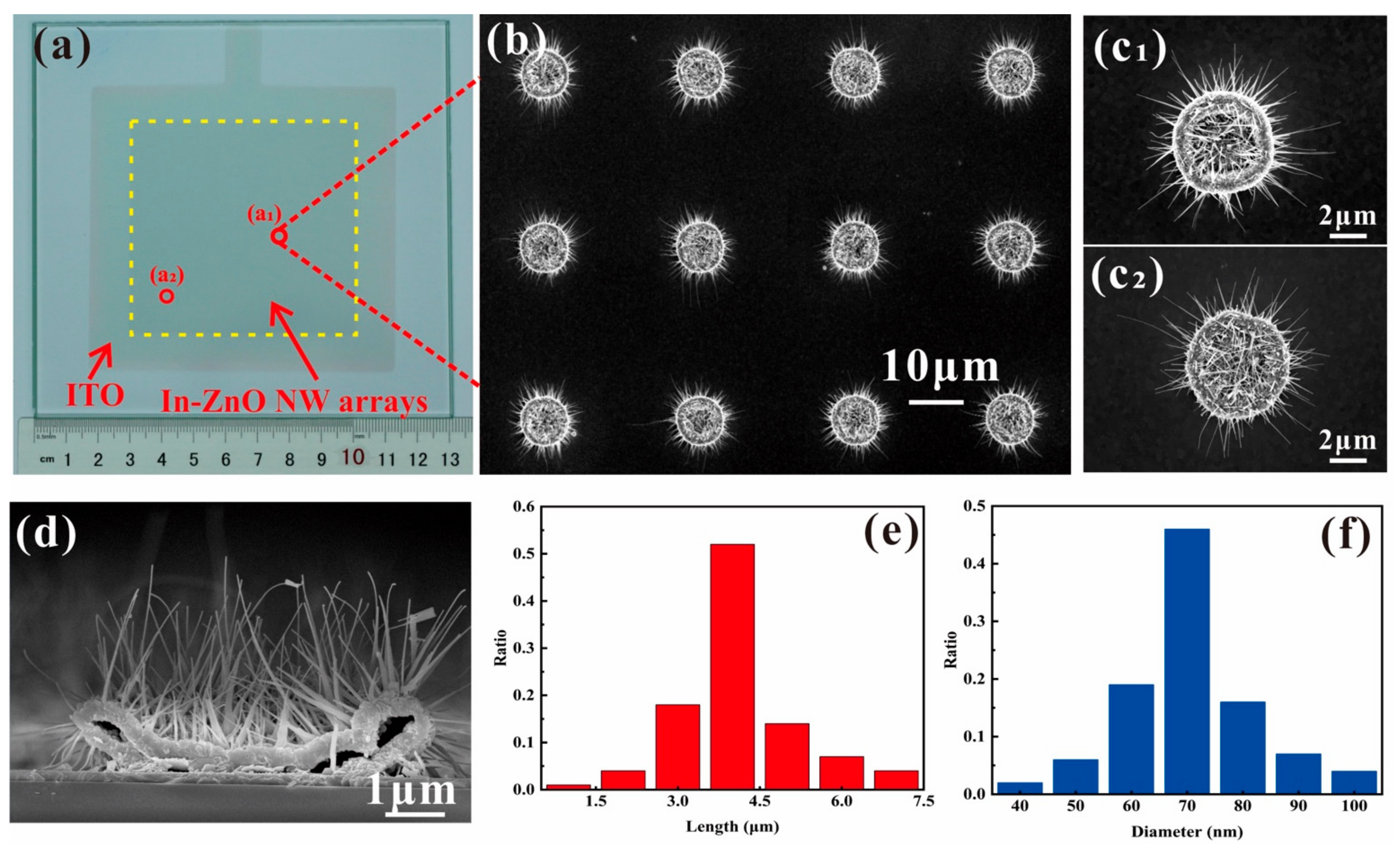
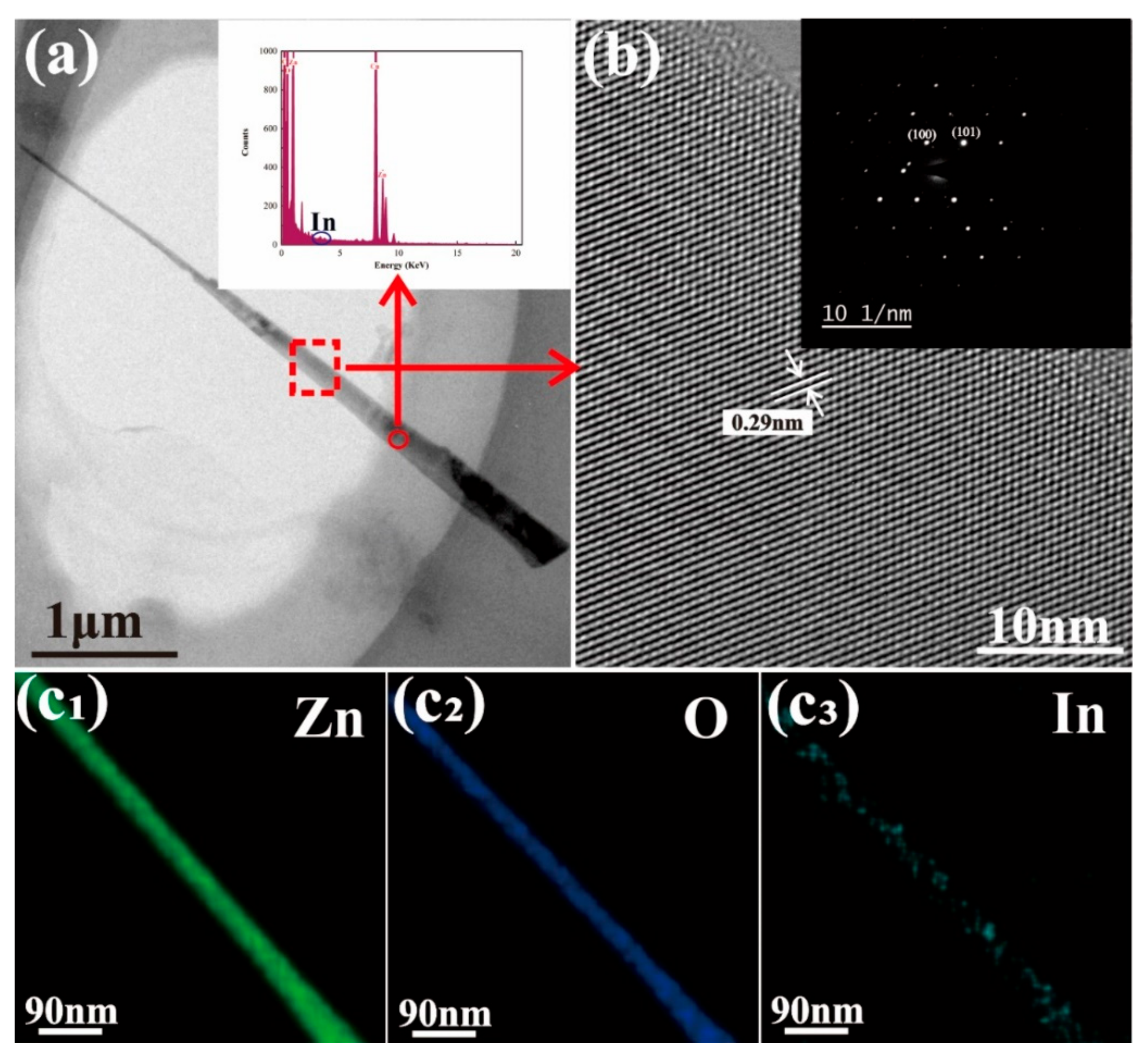

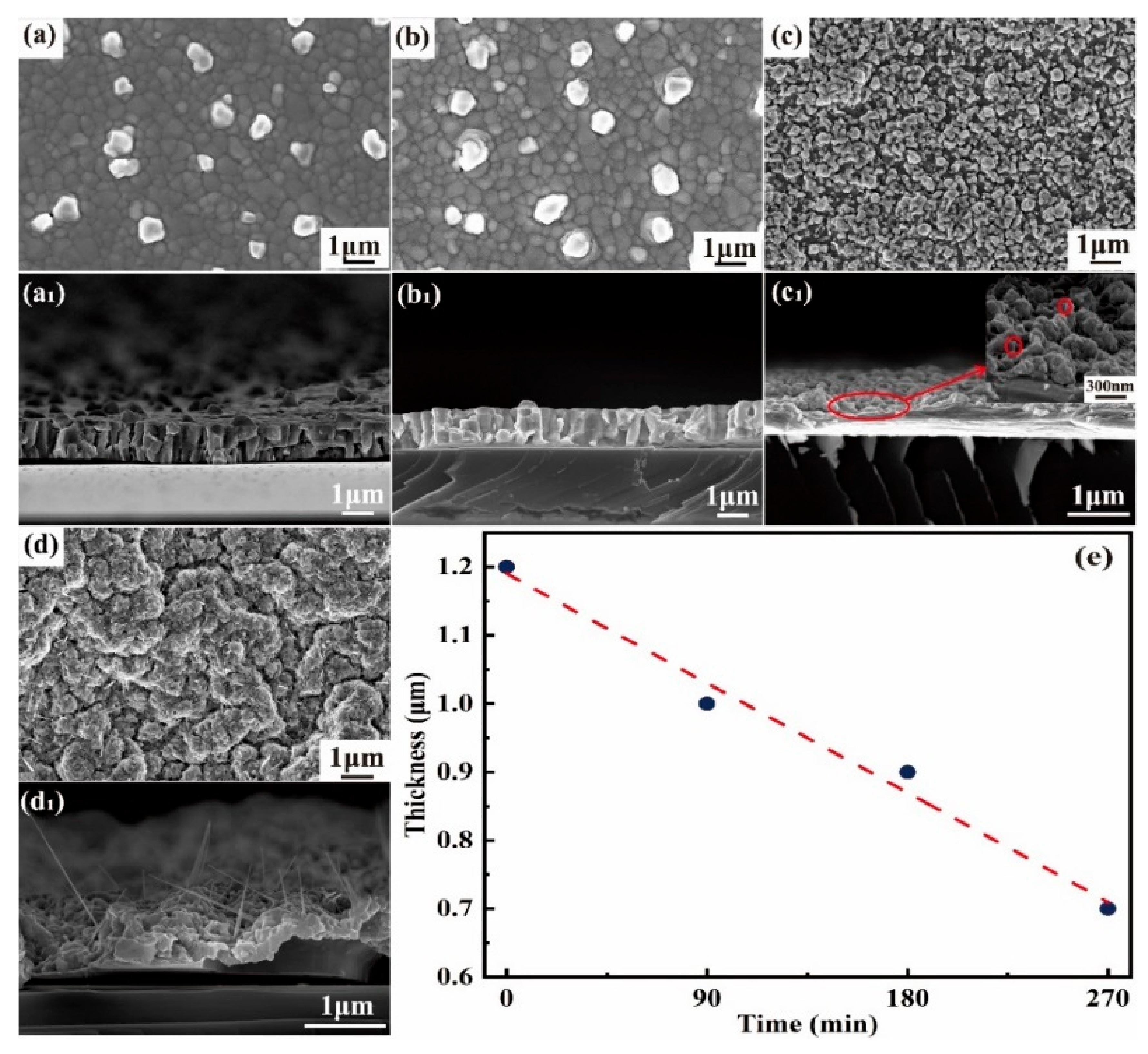


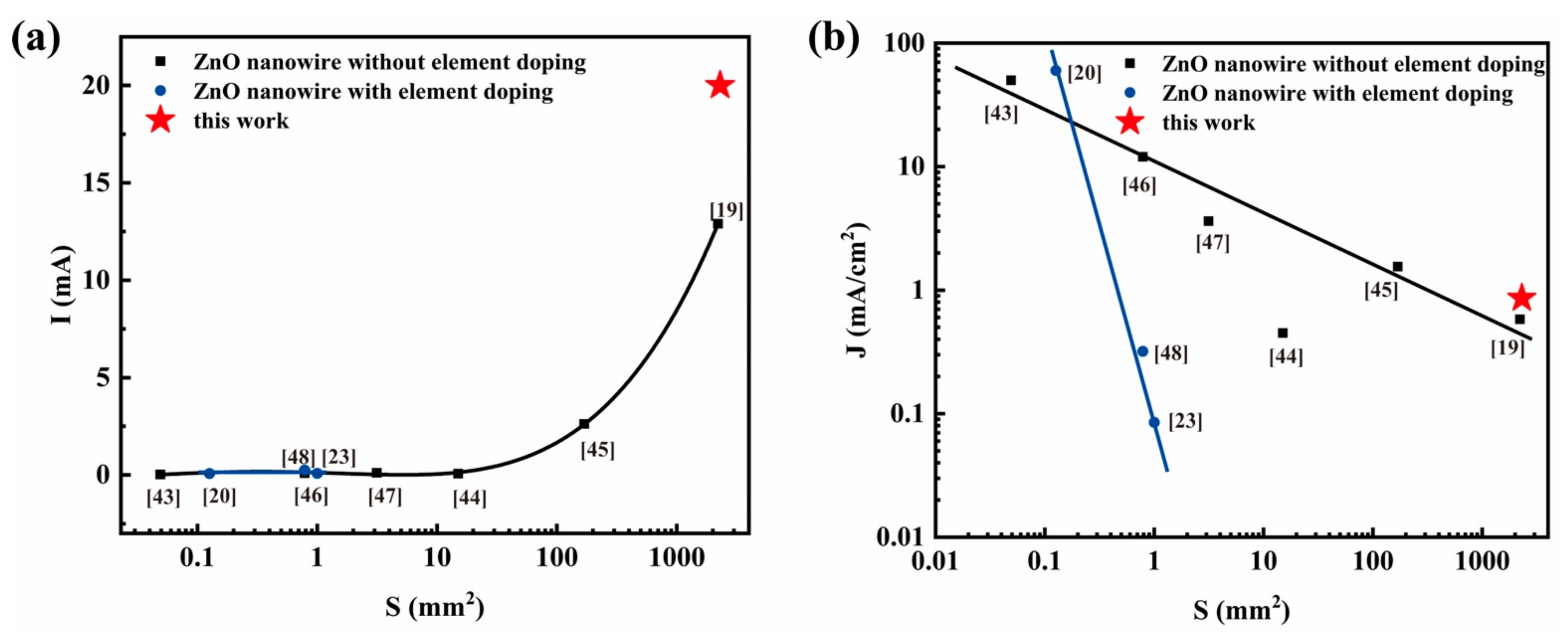
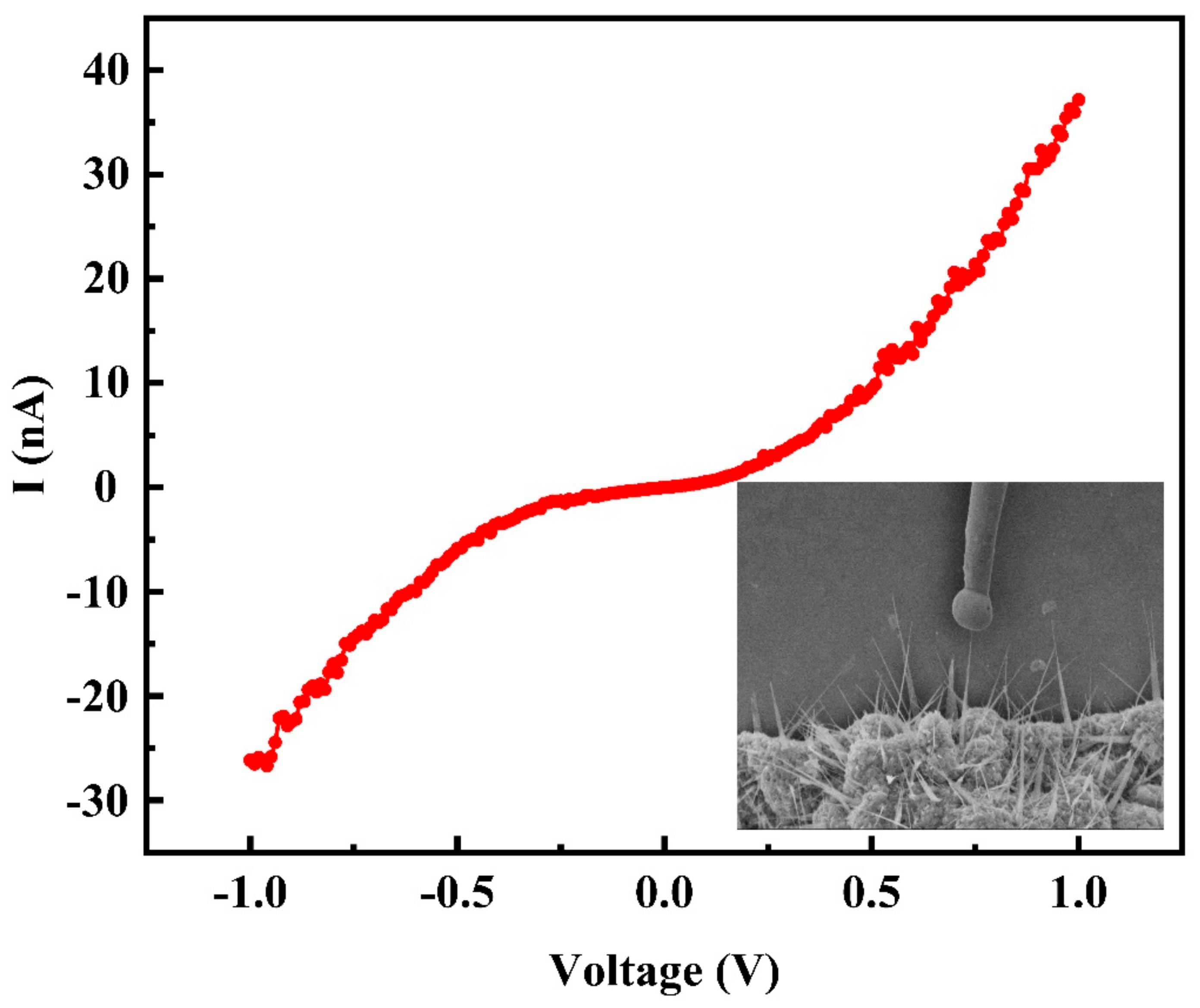

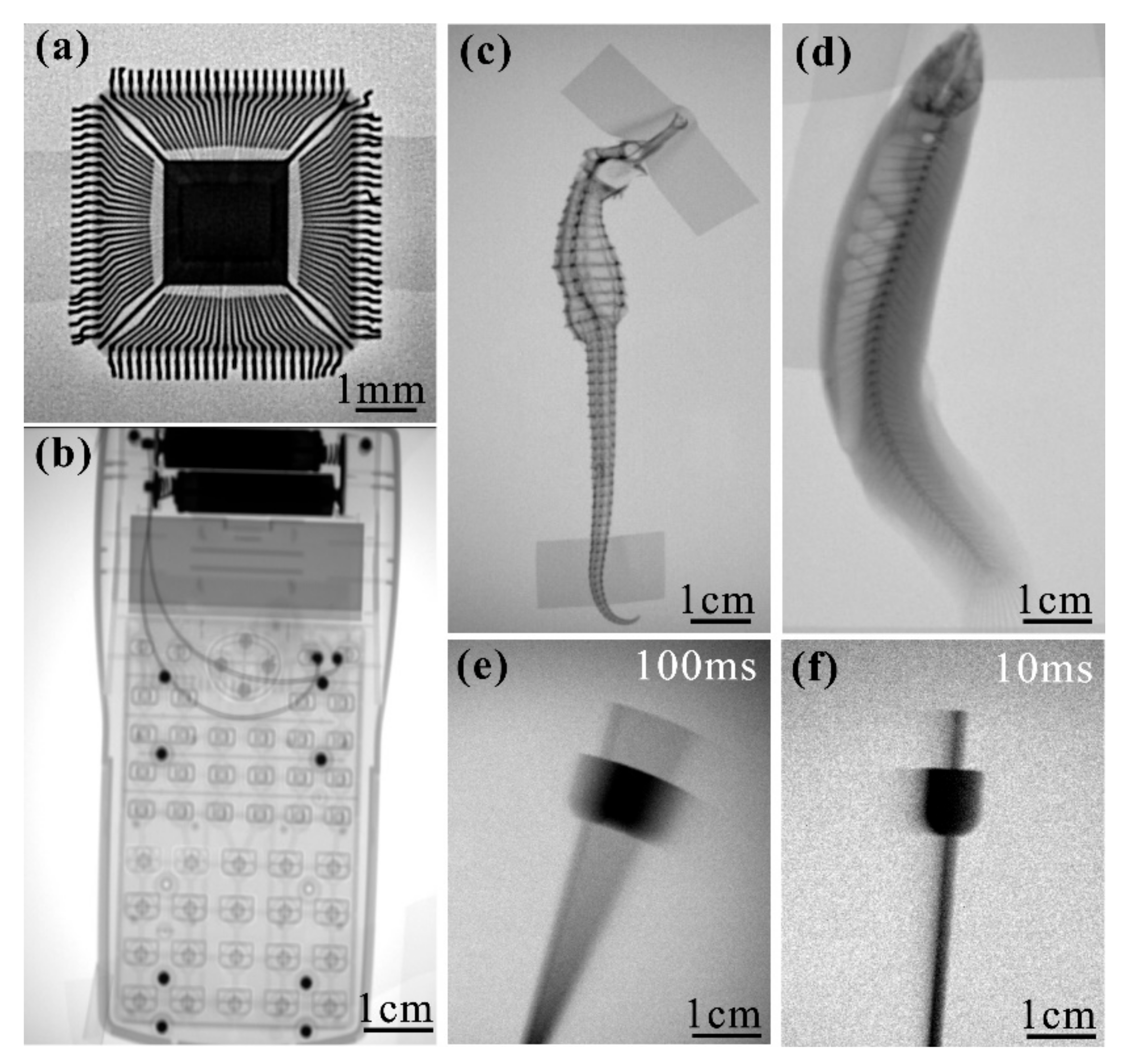
| Samples | Length (μm) | Diameter (nm) | Resistance (MΩ) | Conductivity (S/m) |
|---|---|---|---|---|
| 1 | 3.8 | 80 | 35 | 22 |
| 2 | 4.4 | 41 | 182 | 18 |
| 3 | 5 | 40 | 56 | 71 |
| 4 | 4.5 | 83 | 54 | 15 |
| 5 | 5.1 | 65 | 8.8 | 174 |
| 6 | 5.5 | 69 | 16.7 | 88 |
| 7 | 7 | 57 | 65 | 42 |
| 8 | 4.4 | 67 | 7.2 | 173 |
Publisher’s Note: MDPI stays neutral with regard to jurisdictional claims in published maps and institutional affiliations. |
© 2021 by the authors. Licensee MDPI, Basel, Switzerland. This article is an open access article distributed under the terms and conditions of the Creative Commons Attribution (CC BY) license (http://creativecommons.org/licenses/by/4.0/).
Share and Cite
Zhao, Y.; Chen, Y.; Zhang, G.; Zhan, R.; She, J.; Deng, S.; Chen, J. High Current Field Emission from Large-Area Indium Doped ZnO Nanowire Field Emitter Arrays for Flat-Panel X-ray Source Application. Nanomaterials 2021, 11, 240. https://doi.org/10.3390/nano11010240
Zhao Y, Chen Y, Zhang G, Zhan R, She J, Deng S, Chen J. High Current Field Emission from Large-Area Indium Doped ZnO Nanowire Field Emitter Arrays for Flat-Panel X-ray Source Application. Nanomaterials. 2021; 11(1):240. https://doi.org/10.3390/nano11010240
Chicago/Turabian StyleZhao, Yangyang, Yicong Chen, Guofu Zhang, Runze Zhan, Juncong She, Shaozhi Deng, and Jun Chen. 2021. "High Current Field Emission from Large-Area Indium Doped ZnO Nanowire Field Emitter Arrays for Flat-Panel X-ray Source Application" Nanomaterials 11, no. 1: 240. https://doi.org/10.3390/nano11010240
APA StyleZhao, Y., Chen, Y., Zhang, G., Zhan, R., She, J., Deng, S., & Chen, J. (2021). High Current Field Emission from Large-Area Indium Doped ZnO Nanowire Field Emitter Arrays for Flat-Panel X-ray Source Application. Nanomaterials, 11(1), 240. https://doi.org/10.3390/nano11010240






